Four years ago I wrote about Fire-tailed Resin Bees (Megachile mystacaena) making sticky resin nest chambers in gaps between the weatherboards on our old verandah (see here).
Over the last two months I’ve been sanding and painting this part of the house. Simple job? No, typically for me this has been an epic struggle that, due to all sorts of problems, has expanded to fill endless weekends. Having sanded and painted over a red base coat that seemed solid, I discovered that as the new dark top coats of paint heated up in the afternoon summer sun, the old base coat (possibly enamel or lead-based paint dating back many decades) would apparently release a vapour that caused the newly dried top coat to blister.
Weekends of re-sanding and re-painting, on mild mornings and sun-blasted afternoons, followed. The entire time, the constant buzzing of native Fire-tailed Resin Bees, arriving and departing around me, formed a sonic backdrop to my endeavours. We became well acquainted, and my fascination with these tiny lodgers grew in parallel with my frustration over my painting abilities.
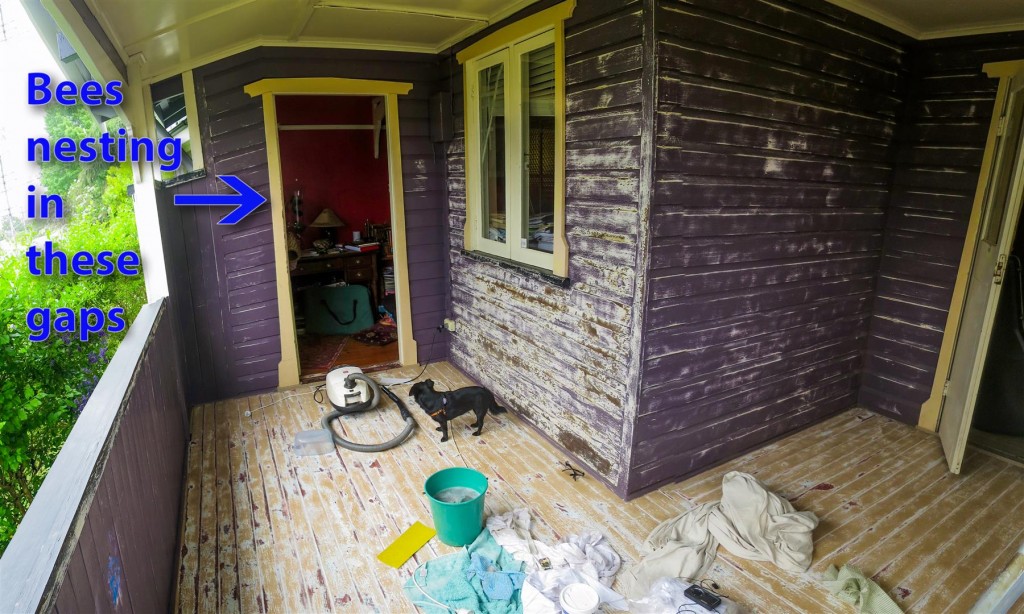
Dodgy photo of dodgy verandah renovations by dodgy renovator, plus small dog. All photos, except where otherwise credited, by Robert Ashdown.
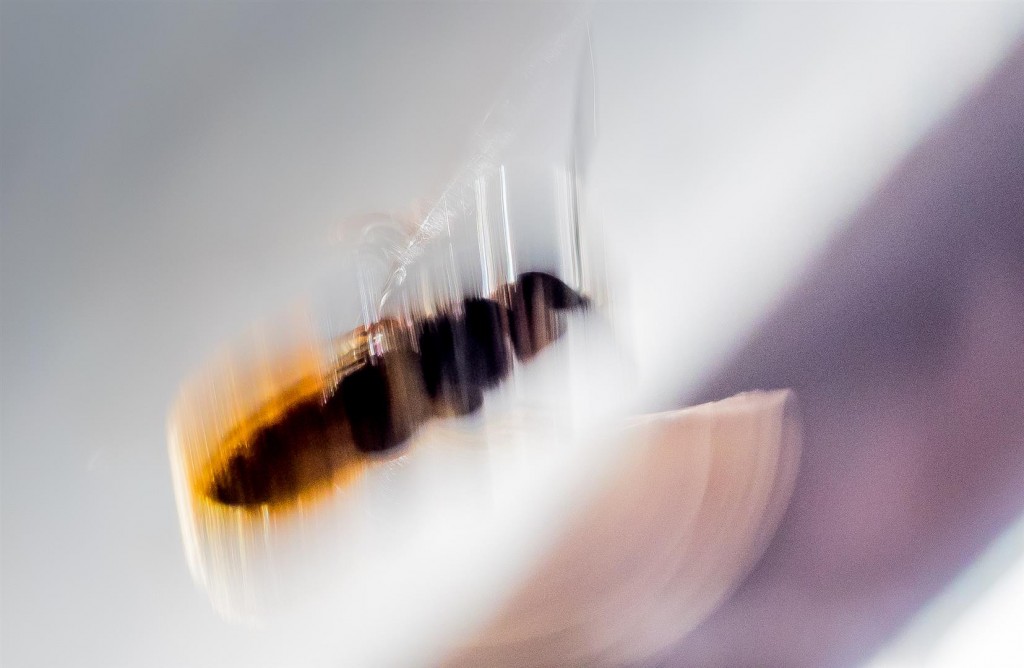
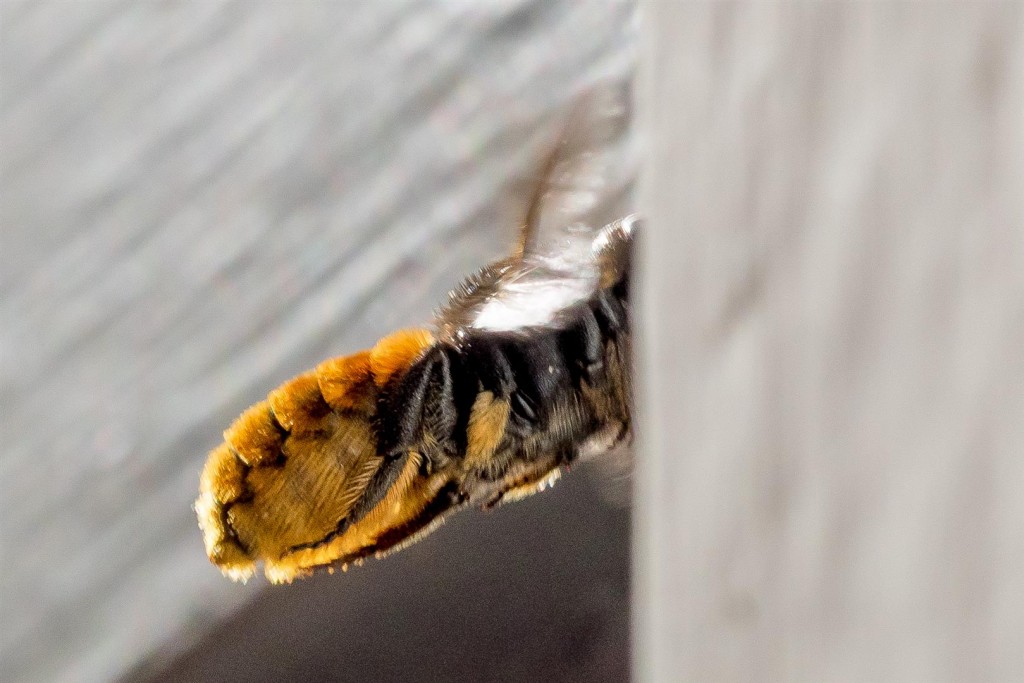
Hover for a bit, then lurch forward into a space. Note the delicate hairs that cover these charming insects.
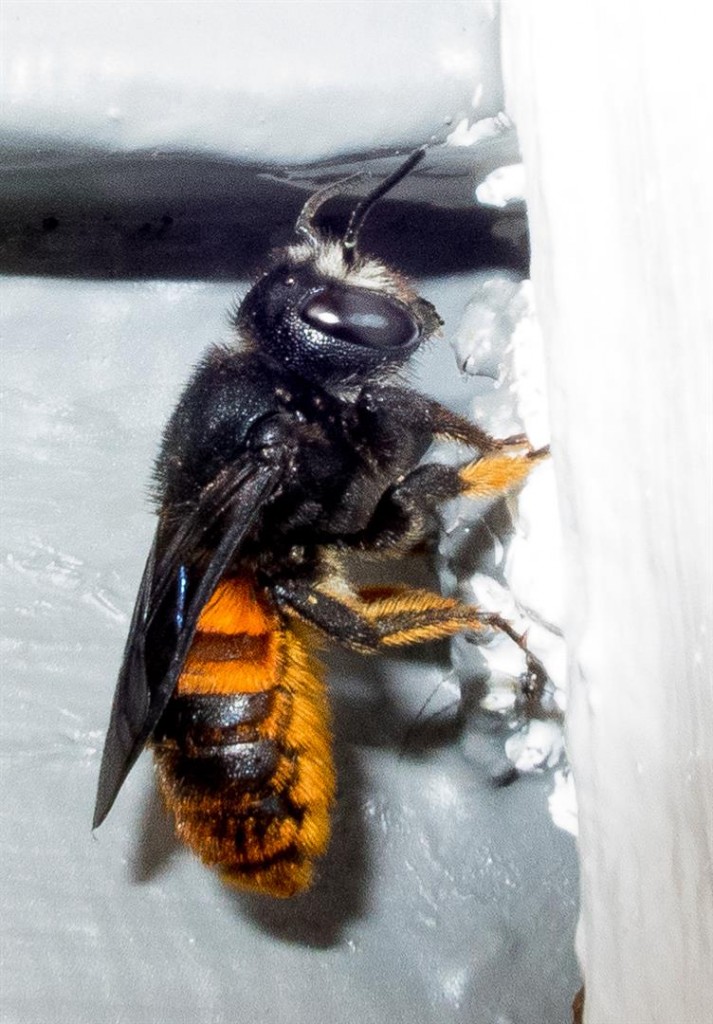
Touch-down!
There are about 2,000 species of native bees in Australia. They are extremely diverse in terms of size, shape and colour. Our bees are classified into five families, three of which are known as ‘short-tongued’ and two as ‘long-tongued’. The ‘tongue’ is actually a flexible hairy extension of the proboscis used for lapping up nectar and for applying secretions during nest-building.
Some other native bees I’ve encountered (above). Click on a thumbnail for a larger image.
Most of our native bees, including the Fire-tailed Resin Bees, are also lumped into a group known as the ‘solitary bees’. Solitary bees do not have queens, workers and drones, and so do not share a nest like European Honey Bees. However, I’ve discovered that they aren’t entirely ‘solitary’, as they do like to build nests for their young in the same great spots as others of their species. My verandah is apparently one of these prime bits of real estate.
Female bees mate and then seek tunnels or cracks in just about anything for their nests. The tunnel is lined with resin and is filled with some pollen, nectar and a single egg.
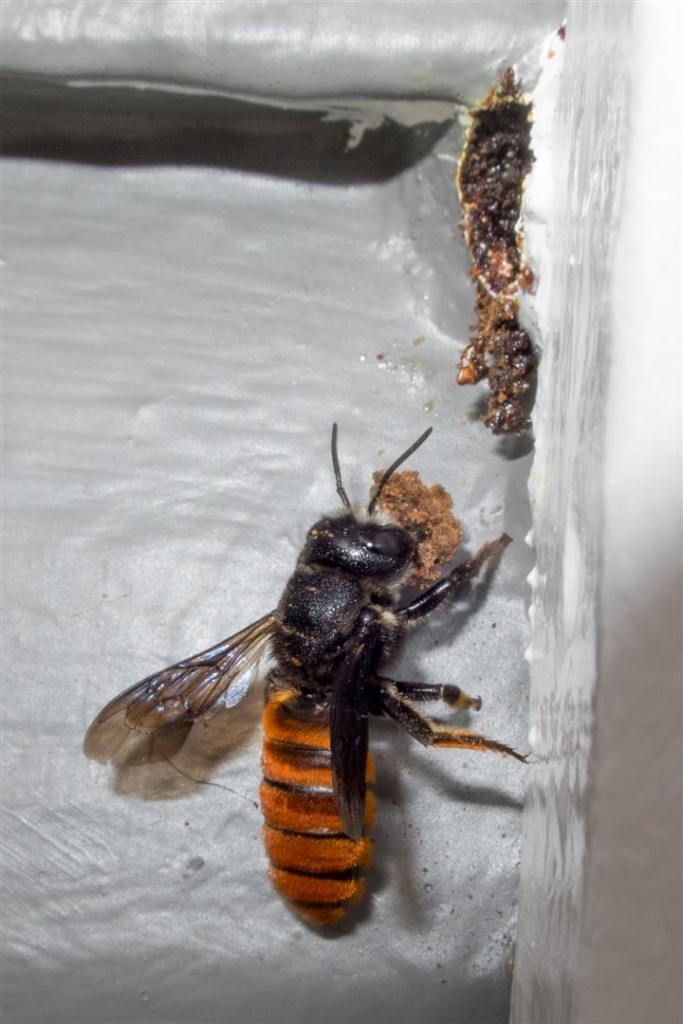
In solitary native bee species, the adult bees generally only fly during the warm months and die before the winter. Immature bees remain sealed in their cells inside the nests during the winter. They develop into adults and emerge when the warm weather returns.
On the verandah, bees (all females as I now knew) arrived constantly, carrying plant material in their mouths or with abdomens covered in pollen. Some air-traffic control was sorely needed. I witnessed mid-air crashes and bees wrestling with each other over the best spaces. I’d have them crash into me or over-fly and end up lost inside the house. They drove the dog nuts. Carrying heavy loads of plant material, some would skitter about on the new wall paint trying to get a grip before slipping and falling toward the floor, coming around for another go at speed.
On several occasions I’d put a paintbrush down and place a finger carefully under a slipping bee so it could get a foothold. My wife suggested sanding the new paint near the nest hollows, and this seemed to help them land. Clearly, these bees were becoming a serious distraction.
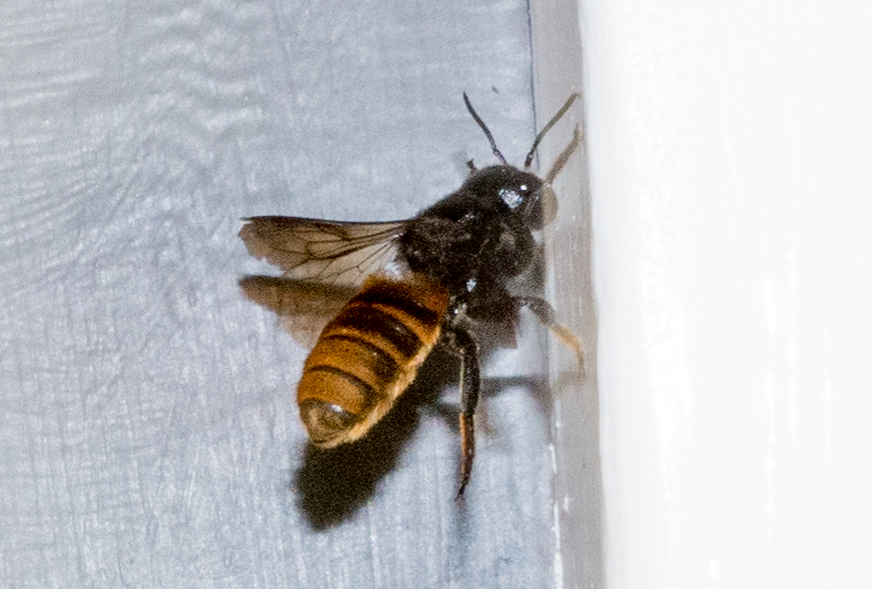
Trying hard to get a grip on slippery new dried paint.
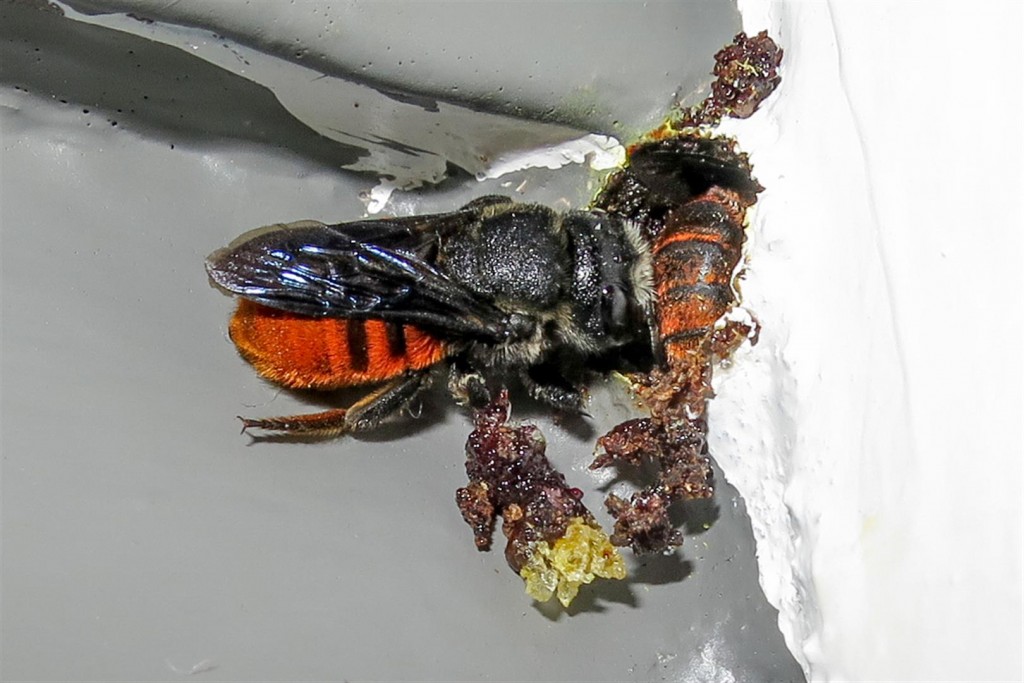
… unless two bees like the look of one space. I reckon one bee here is clearing out, or cutting through, the work of another.
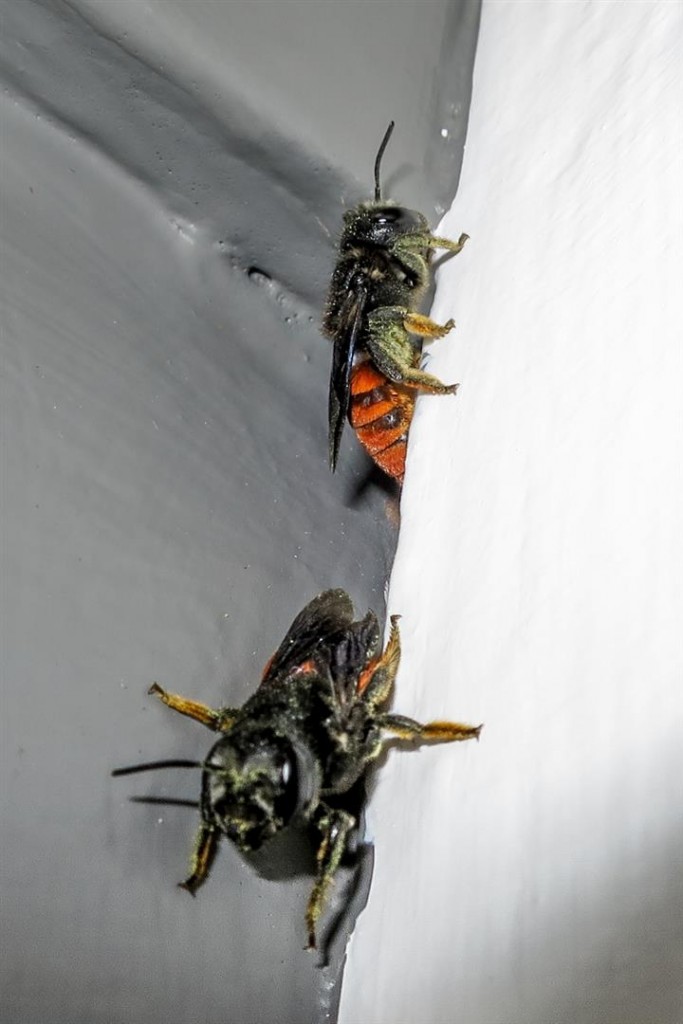
Grrr… trouble, trouble. The girls are grumpy. Or maybe not … possibly sharing a space? Sounds ‘social’ to me.
Oblivious to my expensive wet paint, the bees would throw out black crumbly resin, which of course got stuck in the new paint. Ants would be attracted to it, and then they’d get stuck. There are no workshops on coping with this at Bunnings, Mitre 10 or Masters.
I’d have to apply new paint to the edges of the bees’ nest sites in the cooler mornings, before the bees got active. Otherwise they’d get paint all over themselves, which then stressed them (and me) out.
While painting the floor one morning, a bee, with its ‘weight-to-lift ratio’ ruined by paint on delicate wings and backside, crash-landed on its back and became stuck to the floor. Carrying the bee carefully in a small decorative Christmas bowl with some water, I sat on the back steps and washed paint off the bee with a tiny paint brush as the dog looked on jealously. She hates bees, which are irritating and need to be dominated, since they are in her domain and should be under her control (like us). Helpfully, my long-suffering wife remarked that “My Christmas bowl is not meant for washing paint off bee bottoms!” Possibly accurate.
Eventually, the bee dried off and took off skywards. Returning to the front verandah with paint brush, I spied another resin-laden bee just barely clearing the wet-paint floor. The dog immediately took umbrage, zooming past me and chasing the bee all over the verandah, before running back through the house with paint-covered feet! My shouts further convinced my already suspicious family that my fragile sanity was crumbling. This was becoming a debacle, a combination of my renovational incompetence and the demands of my insect tenants. There was only one solution — give up painting, pick up a camera and attempt some more bee photos.
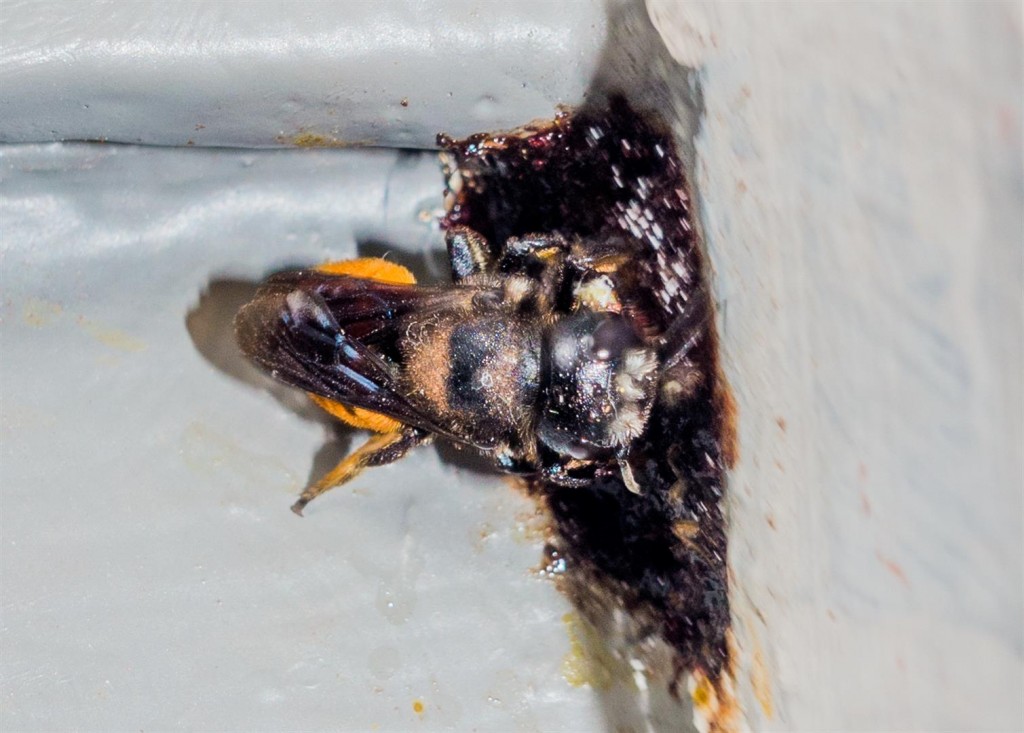
Luckily, resin sticks to Dulux Weathershield paint. Maybe I should let the company know that their products are native-bee certified.
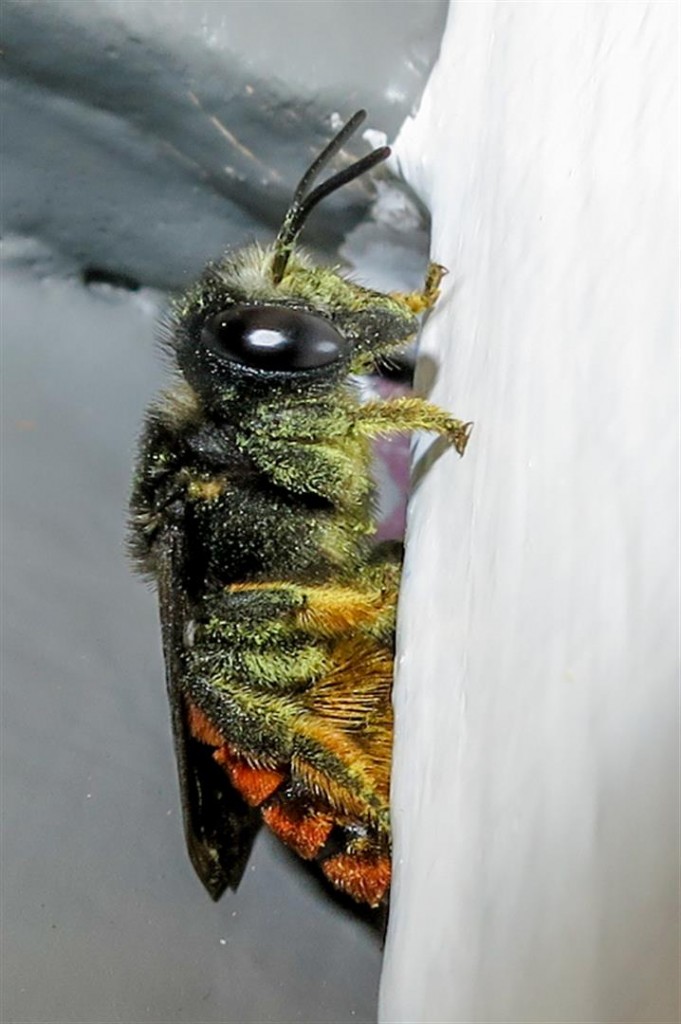
I think this particular bee is dusted with pollen. Spectacular.
Watching these insects, I ended up with some OK photos and a lot of questions, some of which I’ve listed here, with tentative answers.
Are these all male or female bees? How long do they live? Some bees spend the night in their nest chambers — where do the others go after dark?
Male bees play no part in nest construction or brood care, they just spend their time looking for females to fertilise. They usually do this by patrolling the flowers or the nesting areas. Competition for females can be intense and males may fight each other to gain access to females. Territorial behaviour is quite common where males defend a patch of habitat, often containing forage flowers, and drive off rival males and any other flying insects.
Males of many species apparently gather at night in one place. I’d seen this once with another species of native bees — Nomia Bees.
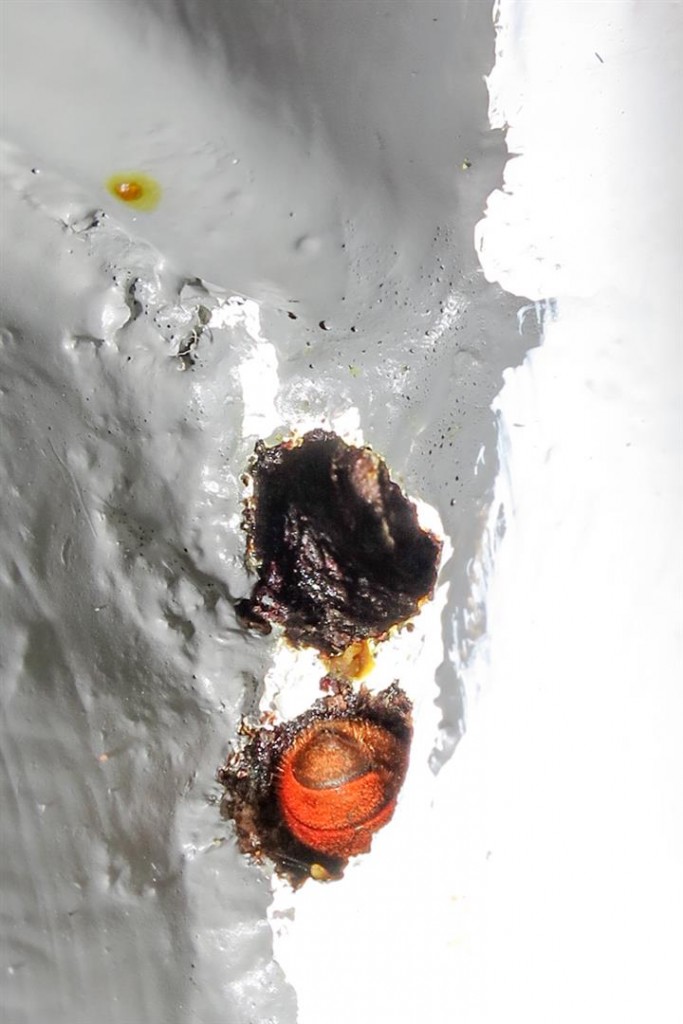
Middle of the night. All is quiet on the verandah, some bees asleep in their nest spots.
What exactly are they doing out of sight in the wall cavity?
It seems that the plan is something like this:
- Gather pollen and/or nectar from the garden.
- Bring back resin from a source somewhere out there.
- Avoid the wet paint, dog and amateur renovator.
- Line the walls of the chamber with resin.
- Deposit some food material for their larvae in the chamber.
- Lay an egg in the chamber with the food.
- Seal off the chamber completely.
The Western Australian Museum reports that while both sexes of resin bees feed on nectar, females usually thicken it into honey before taking it back to their nests. They do this by regurgitating the nectar onto their mouthparts, exposing it to the air to evaporate excess water. They alternately regurgitate and re-swallow droplets of nectar until it reaches the required consistency.
Females of most kinds of bees carry their pollen loads on specialized sets of hairs (termed ‘scopae’) on either the hind legs or the underside of the abdomen. Such pollen loads immediately distinguish the insects as bees. Bees in the family Megachilidae carry pollen on the underside of their abdomen. Unlike honeybees, they do not have pollen baskets on their hind legs.
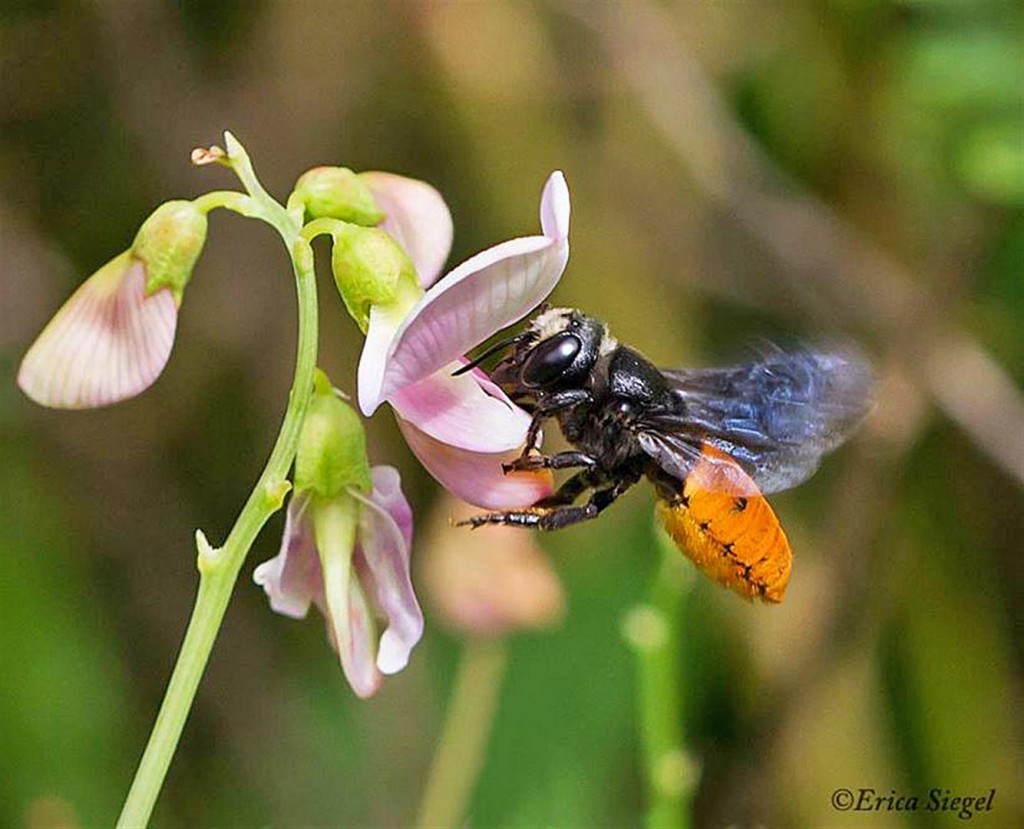
Out in the world away from the verandah, a fire-tail obtains nectar from a flower. This beautiful photo courtesy of Erica Siegel.
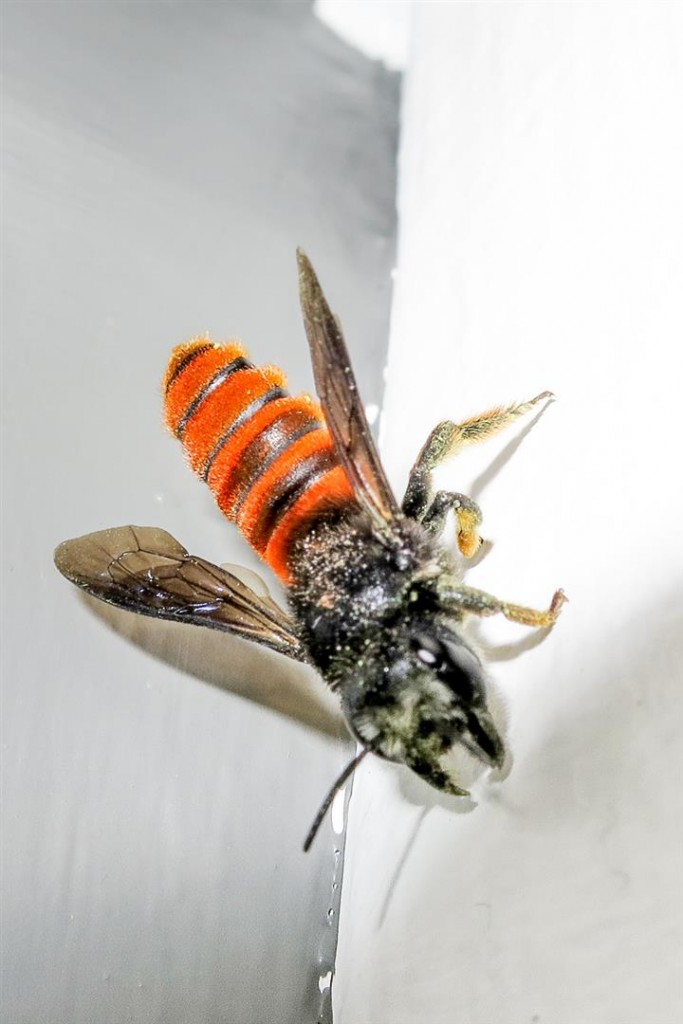
These bees have strong mouth-parts for chewing up plant material and fashioning stylish resin nests.
Pollen and honey are usually combined in the nest to form the larval food, either as a solid, rounded mass or as a fluid or semi-fluid paste. Either way, the egg is deposited on top of the completed provision. Each brood cell is a cavity providing a protective environment for the development of a single individual; it is stocked with sufficient food to enable development from egg to adult and is sealed once it receives an egg.
I noticed that several bees sometimes seem to use the same chamber — is more than one egg laid in a chamber by different bees?
Where does the resin come from?
The resin they are using at my place is a deep red/purple colour. They are reported to use resin from eucalypt species, but there are not too many gum trees in our suburban block now. The nearest resin or sap I’ve seen is leaking out of local camphor laurel trees, and some pine trees, in a local park about 500 metres away — I wonder if they use resin from these exotic species?
Some bee-keepers have reported resin bees hanging around stingless bee hives, trying to ‘borrow’ a little resin for their nests. They have been seen ‘balling up’ the resin with their front legs, although the bees bringing resin back to our place seem to be carrying it in chunks. They appear to work it into place with their jaws, and I’ve also watched them rubbing their abdomens on the resin. Are they secreting something to help work it into shape? Some species have also been recorded chewing leaves to add to the mix.
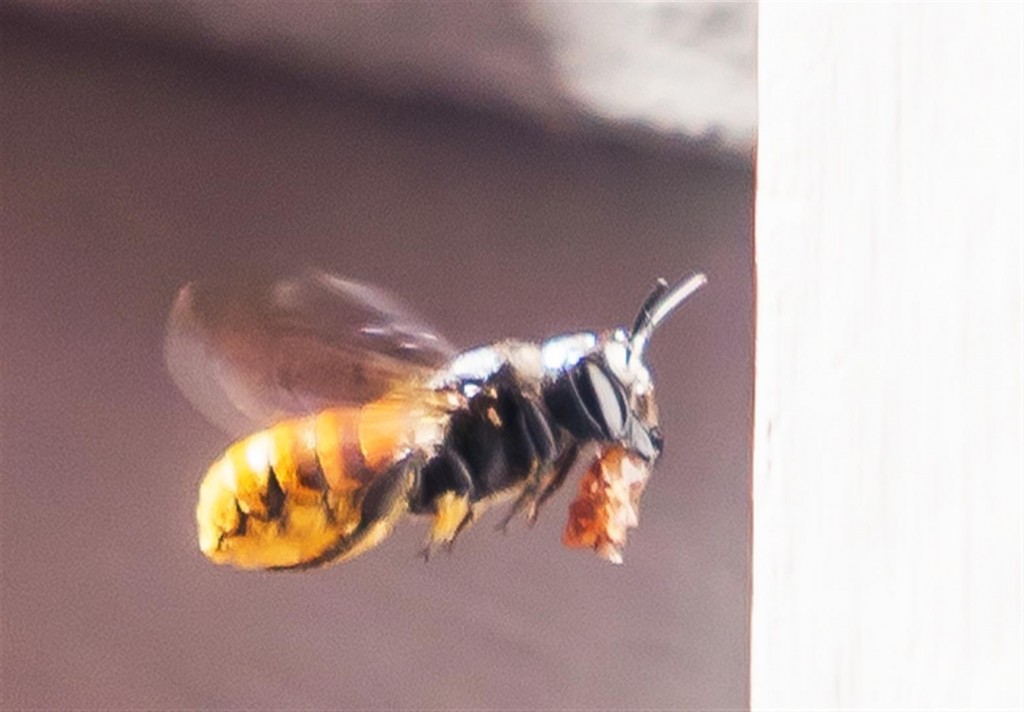
A bee approaches the wall with a prize chunk of resin firmly gripped in the mouth.
In the USA, researchers have investigated native resin bees, from the same genus as our fire-tailed species, incorporating pieces of plastic shopping bags into their nests in addition to the usual leaves, as well as sealing the nest cavity with plastic-based sealants, including caulk.
The study offers another example of how animals adapt to human-dominated environments. “There will always be those that have adaptive traits or enough flexibility in their behavior to persist in a disturbed landscape,” they report (see link below).
What happens to the larvae?
Once hatched, the eggs progress through larval stages and subsequently will overwinter as pupae. Young bees must bore their way out of their cells and find their way to freedom. Bees that nest in hollow stems and borer holes construct a series of cells, end to end along the galleries.
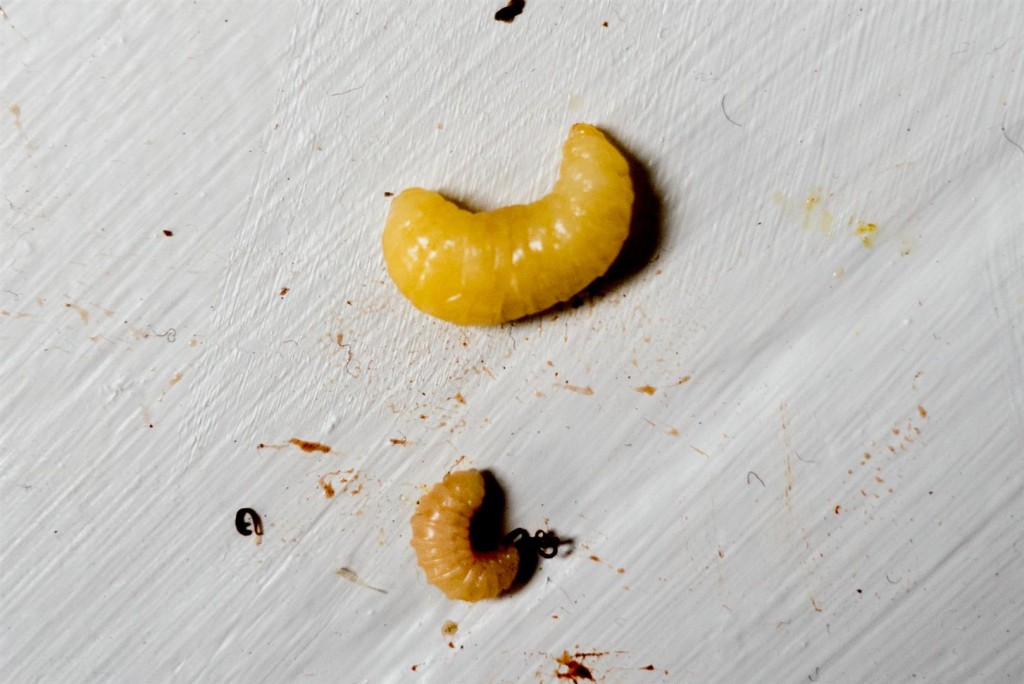
I’d sometimes discover tiny bee larvae on the verandah floor in the morning. One was still alive so I attempted to get it back in a nest chamber. I can only assume that some bees remove the larvae of other bees at night as they compete for the best nesting hollows.
They face some dangers. The Western Australian Museum reports that bees’ worst enemies are mould, mites and parasitic insects — certain wasps, flies and beetles.
I sometimes observed other flying insects hovering around near the bees and finally managed a (bad) photo of one on my phone. I think this is a parasitic wasp of the Chalcididae family. These attempt to break into the bees’ freshly completed brood cells to deposit their eggs. The wasp or parasitic bee larvae, upon hatching, destroy the host egg or young larva and take over the food store.
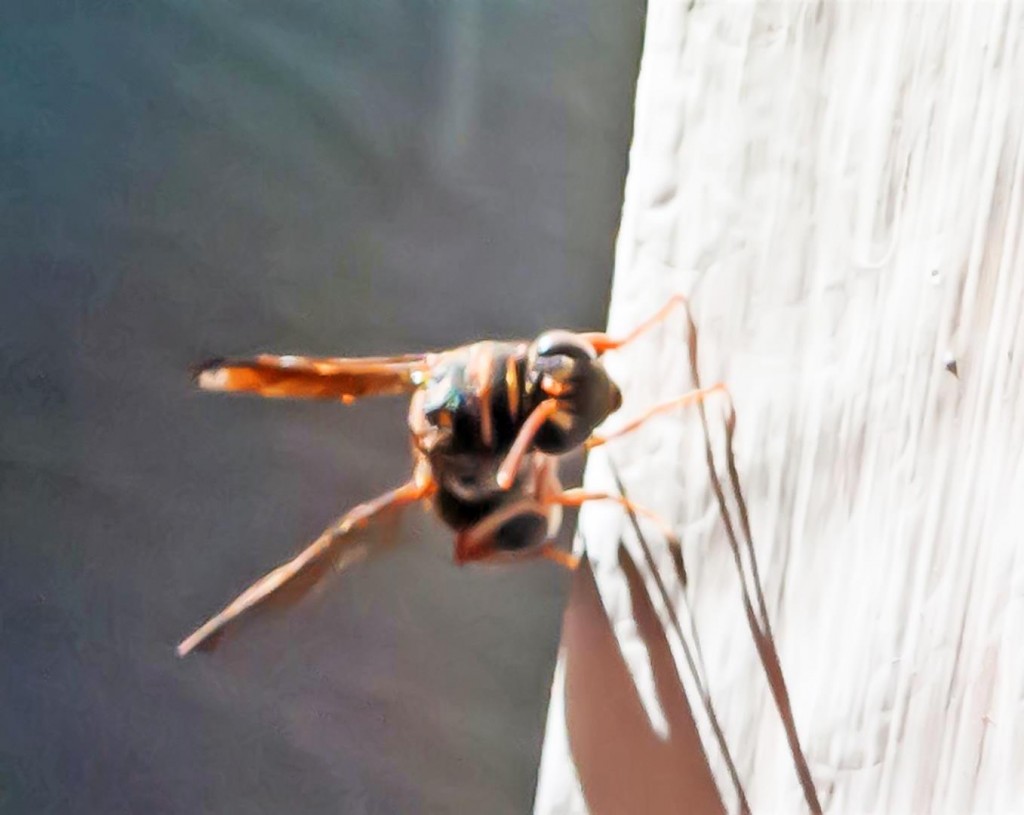
Bad news for a bee. Parasitic wasp on the prowl.
Are native bees important pollinators, and how are they going in general?
Native bees are important and efficient pollinators of a wide range of plant species — including crops and native species. They are also in trouble. Wild and native bees the world over are declining in numbers or disappearing completely.
While it is true that native bees are not experiencing ‘colony collapse disorder’, they suffer from many of the same problems that the more ‘glamorous’ animals are experiencing. Chief among these are loss of habitat and habitat fragmentation. And when the habitat is lost, native food sources and nesting environments vanish as well.
Native bees are also subject to the pesticides. All types of pesticides have been found to harm bees, including fungicides, herbicides, acaricides, rodenticides, and of course the ubiquitous insecticides. Since native bees are closely tied to their food source, anything that destroys the food source—whether it’s a herbicide, a freeway, or a housing development—destroys the native insects that were dependent upon it.
A park here, a field there, and a garden down the road are not enough to maintain populations in the long term. Habitat fragmentation destroys the ability of populations to freely intermingle, and soon the genetic pool becomes small and lacks diversity. This is a major step on the road to local extinction. Add enough local extinctions together and a global extinction will follow.
— Native Bee Conservancy
Russell Zabel outlines the known reasons for declines in populations of Australian native stingless bees, and these reasons would surely apply to many species of Australian native bee:
Native Bees are found in the hollows of dead or damaged trees. There are a number of reasons for their reducing population:
a. Land owners generally do not leave trees to grow old and die, therefore hollow trees are scarce.
b. Dead trees are considered a danger to livestock breeders and are therefore removed.
c. There is a possibility that poisons used for rural applications are killing out these delicate little insects.
d. Land developers are using the technique called ‘Selective Clearing’ to improve the sale potential of their allotments. Consequently, we see the trees containing native bees dozed into a heap and just burnt.
At the same time it’s clear that, as with so many components of our biodiversity, we don’t even have the full picture about what’s out there. New species of insects, including bees, are being discovered all the time. For example, in September 2015, four new native bee species were found in the Pilbara region of northern Australia. Three of these new species have special narrow heads and unusually long mouth-parts that allow them to feed on the slender flowers found on emu bush, a hardy native of the Australian desert.
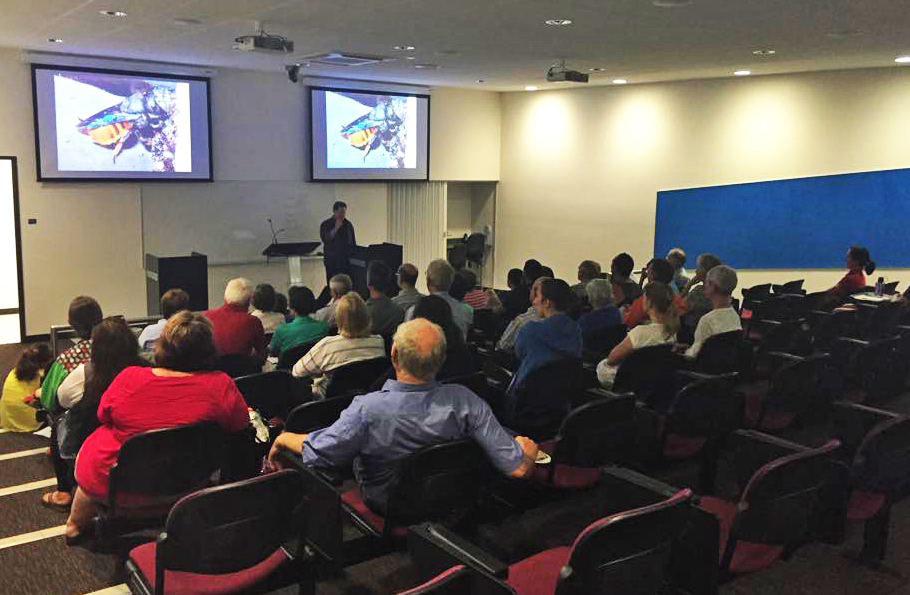
Talking about resin bees to a bunch of fellow naturalists at the November meeting of the Toowoomba Branch of the Wildlife Preservation Society of Queensland.
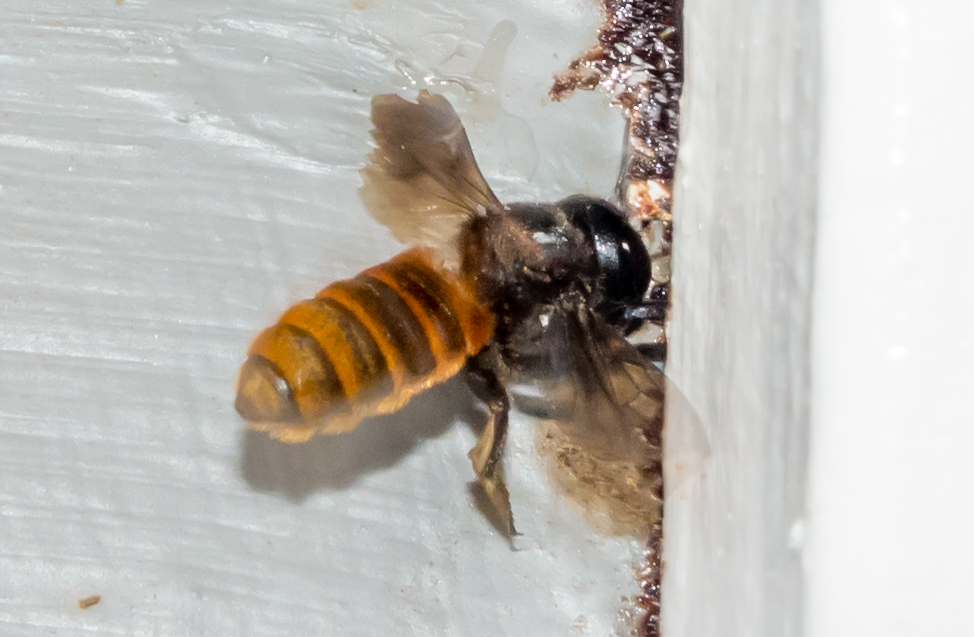
By late January, there are nine separate nest chambers either finished or under way on our verandah. Some of the bees have tattered wings, a sure sign of a long, hot nesting season. Perhaps their short life spans are running down. I have huge admiration for these fearless builders.
It’s now mid February and the mornings and evenings are slowly getting cooler. The verandah is finished, and so are the bee’s resin nest chambers. There is no sign of any visiting bees — perhaps their short adult lives have come to an end. While we sit and enjoy the revamped verandah, the next generation of resin bees are slowly growing inside the walls. I hope we’ll see them around again next Summer.
LINKS
- Wonderful photos of native bees by Erica Siegel — Aussie Bees and Flickr gallery
- Museum of Western Australia — Article on solitary bees by Terry Houston
- Australian Stingless Bees
- Aussie Bees
- Resin bees using plastic
- New bee species discovered
- Pollinator links
- Spectacular native bee photos by Laurence Sanders
Thanks to Erica Siegel and Russell Zabel.

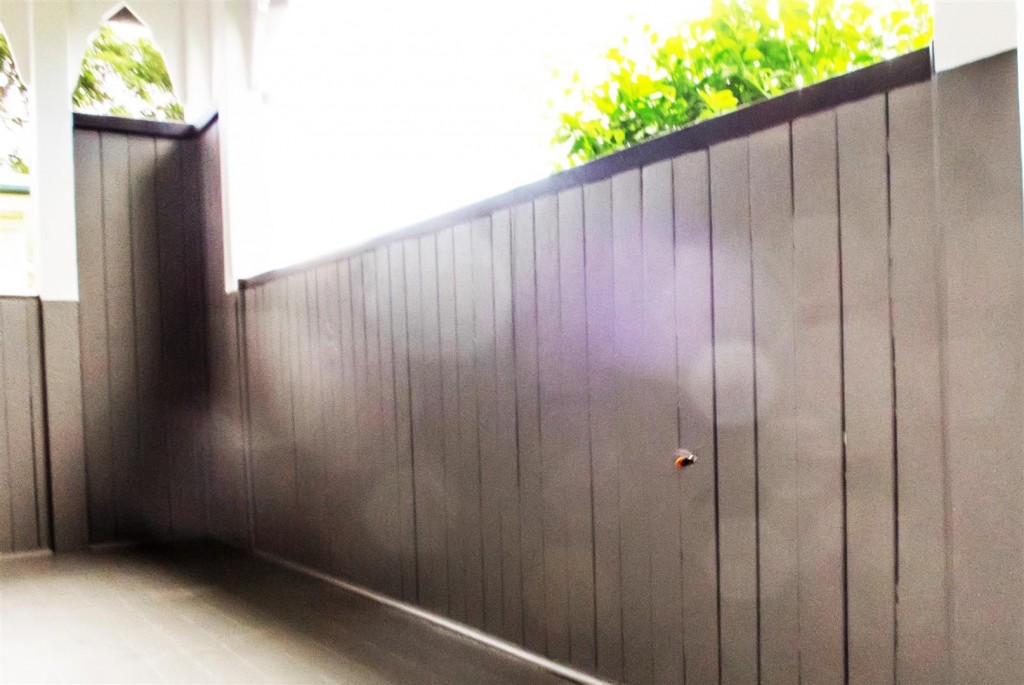
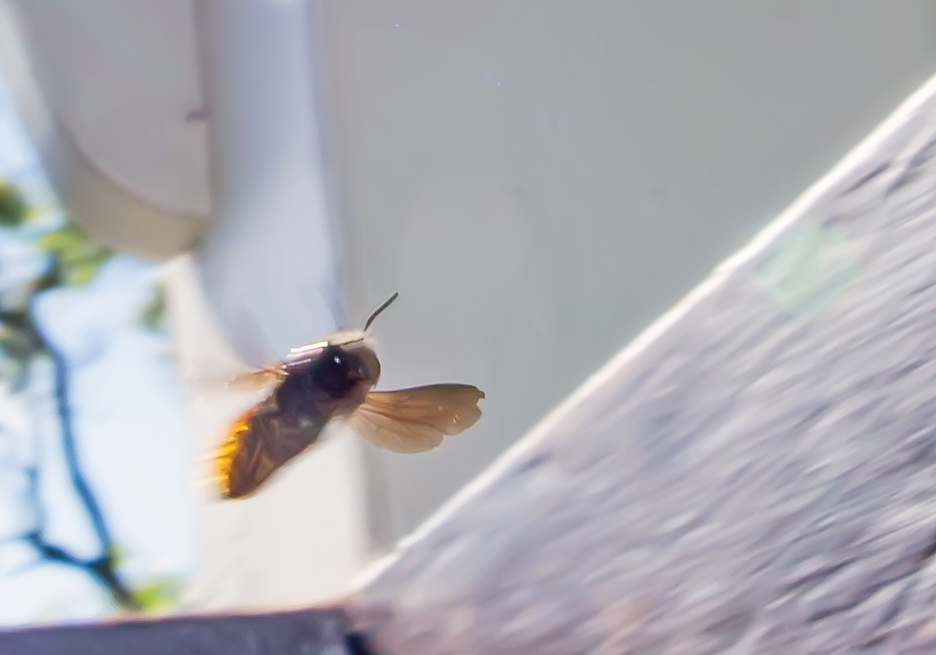
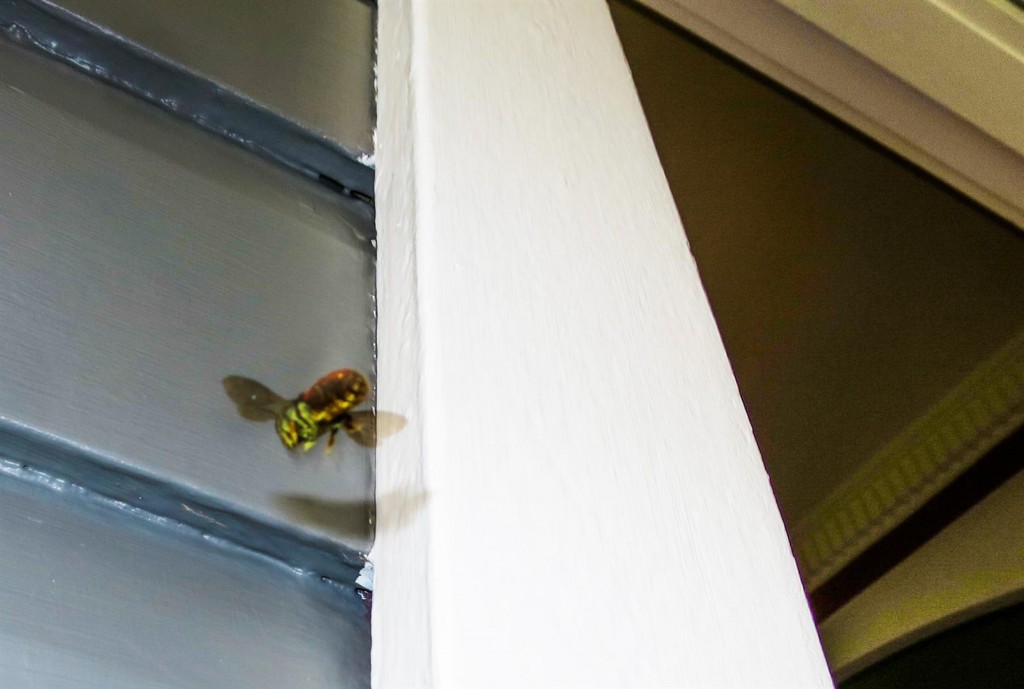
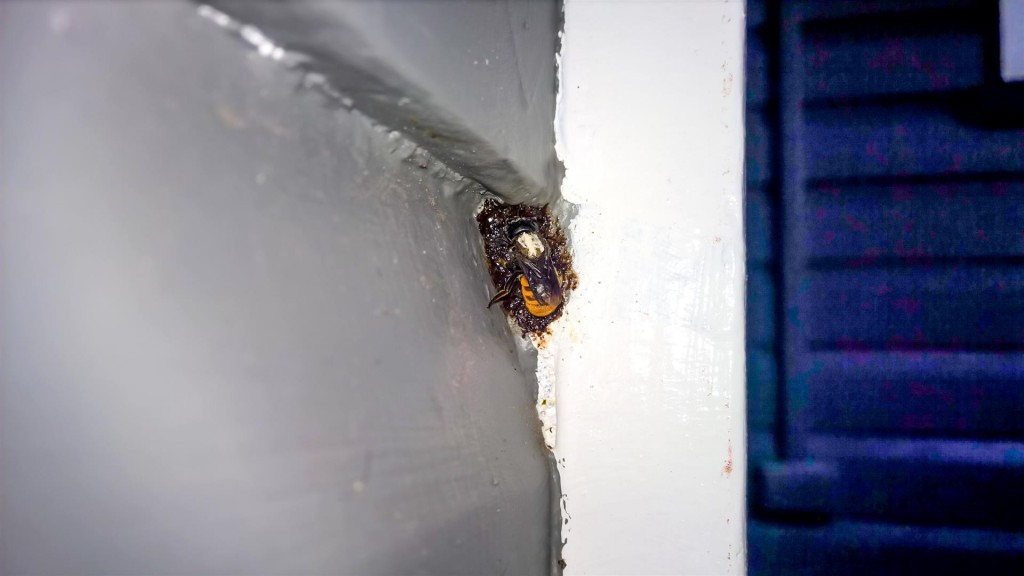
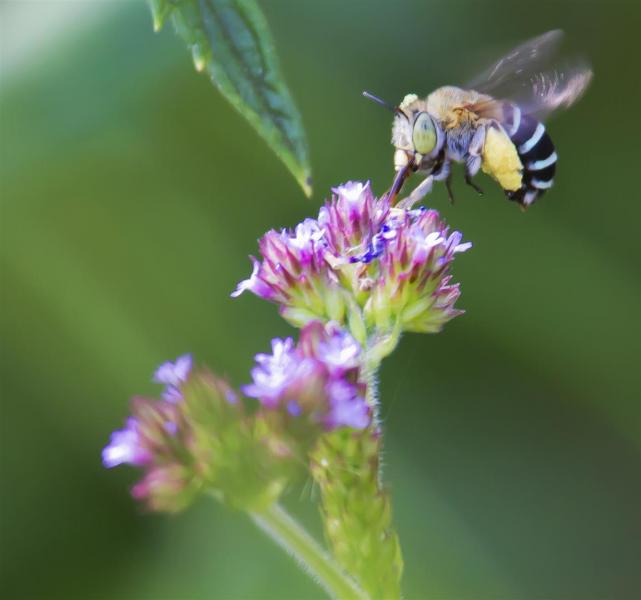
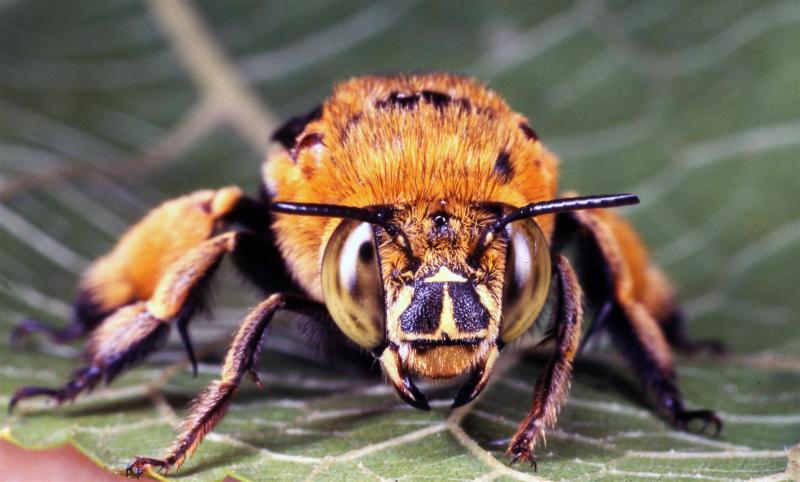
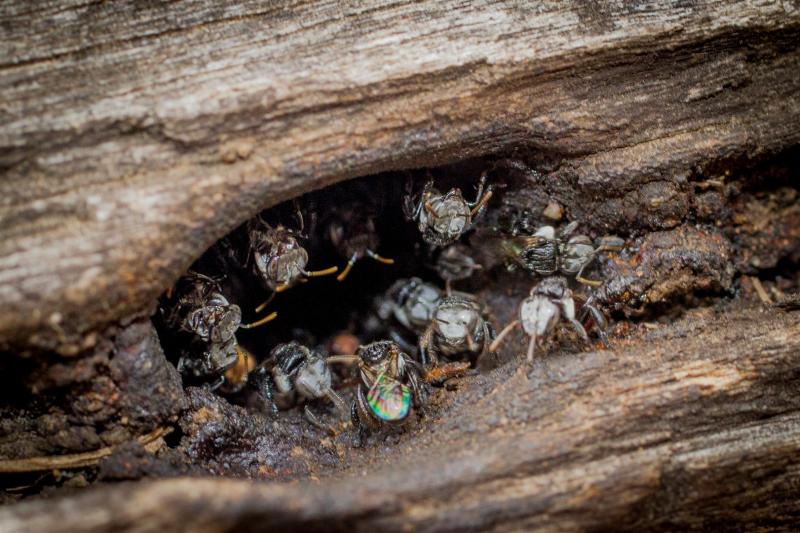
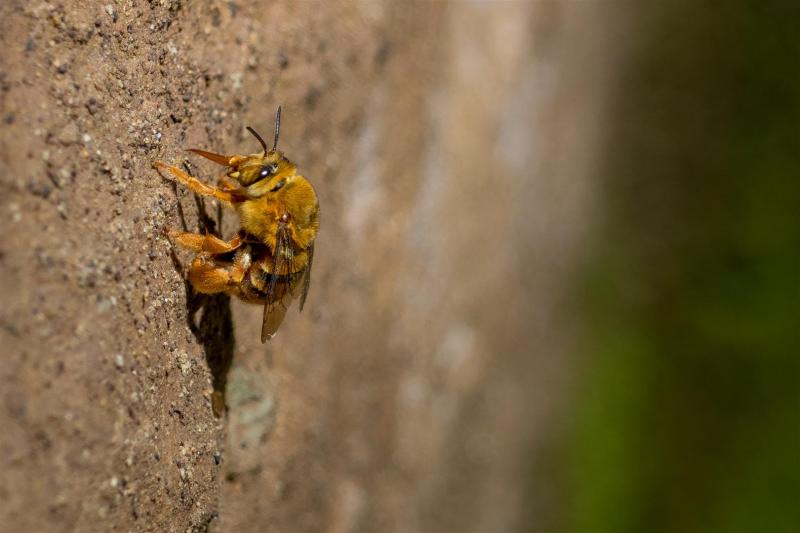
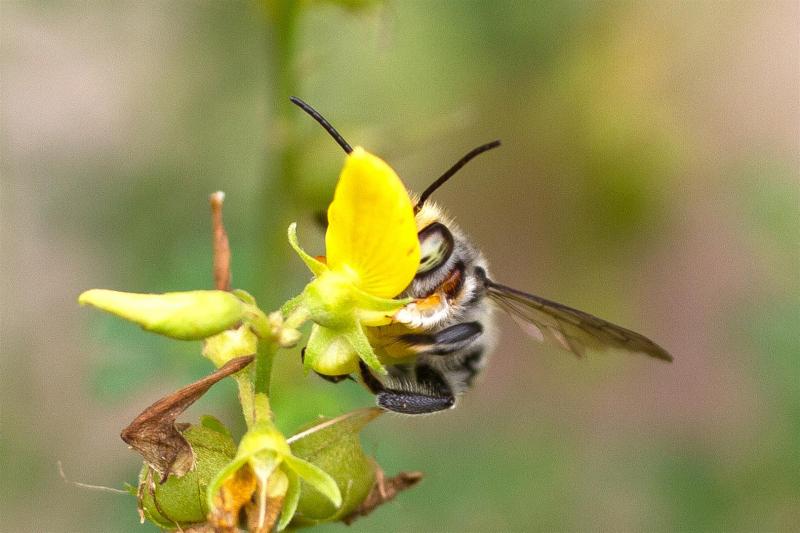
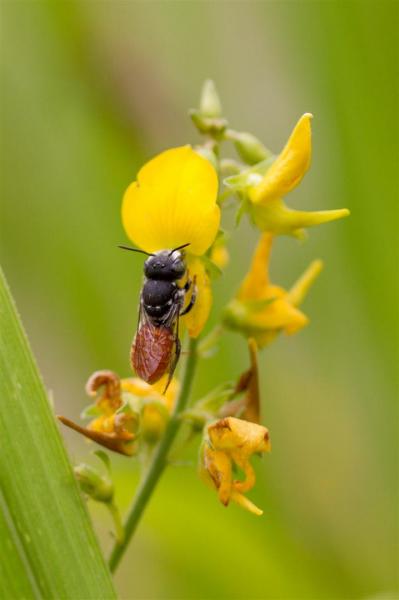
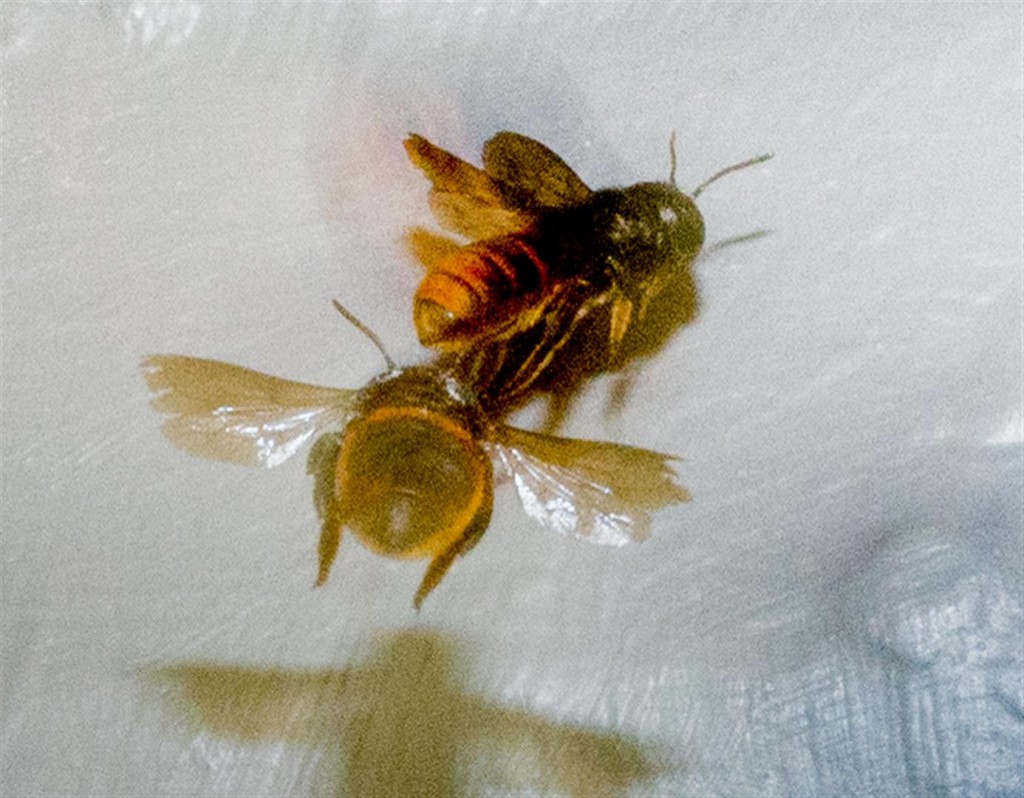
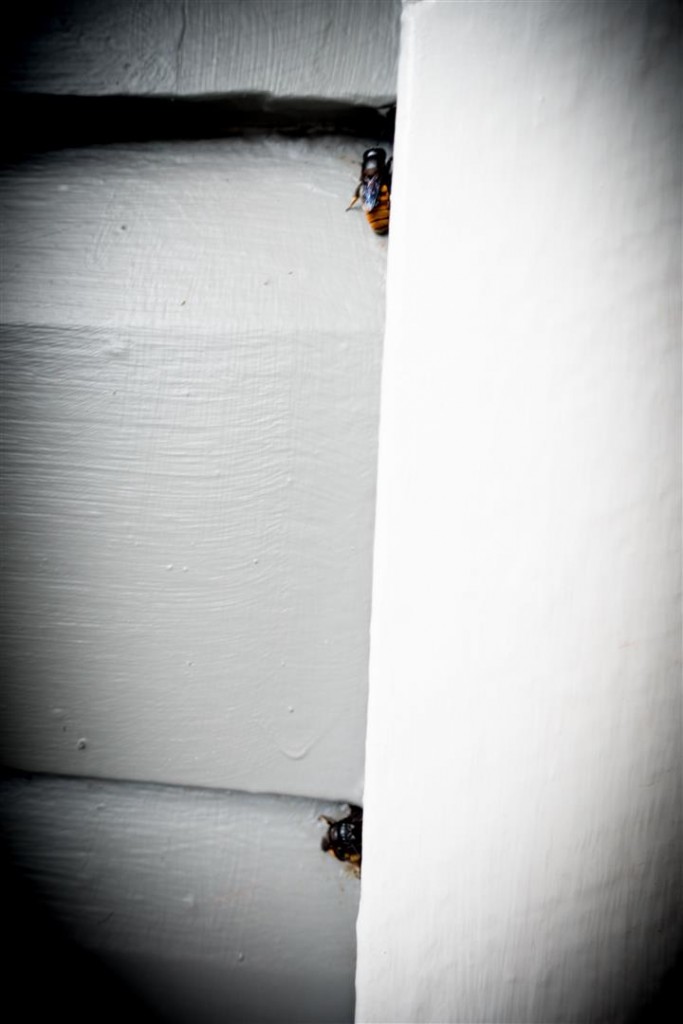
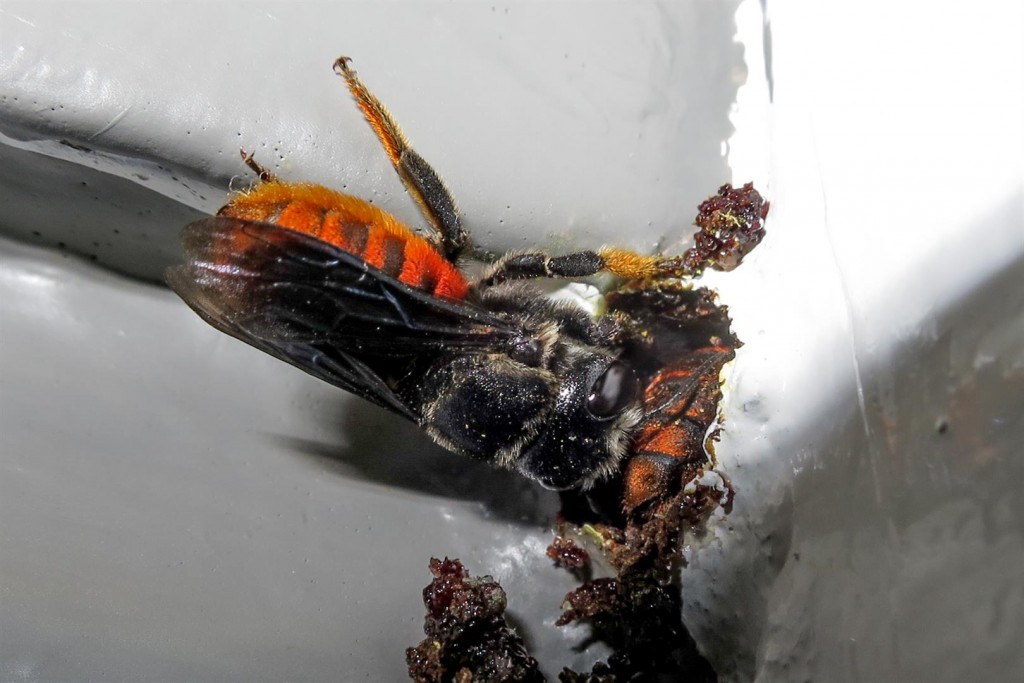
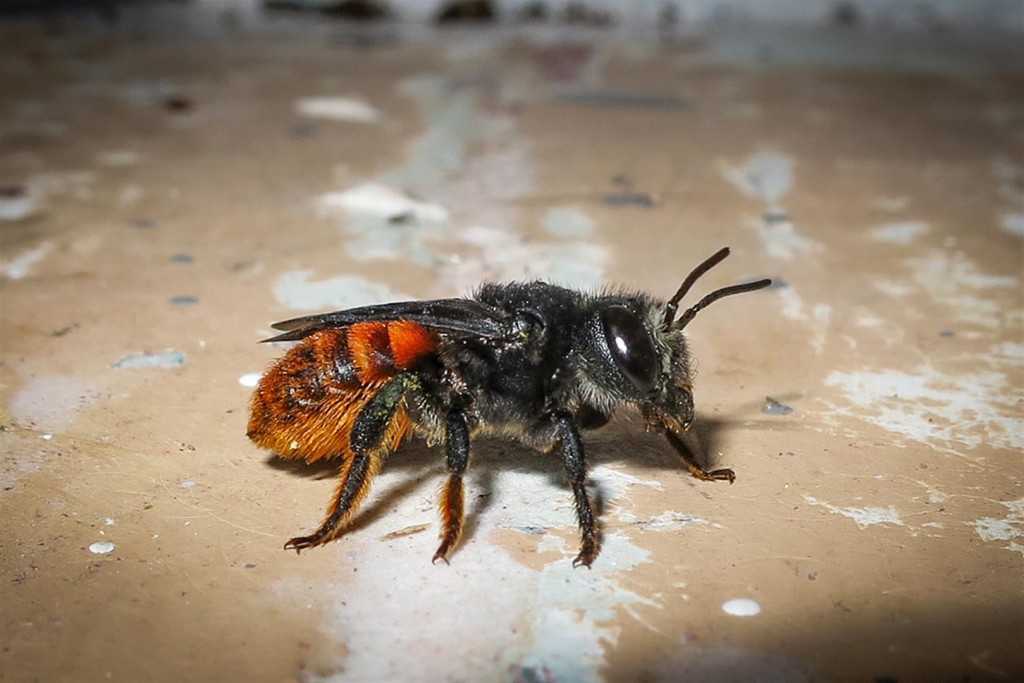
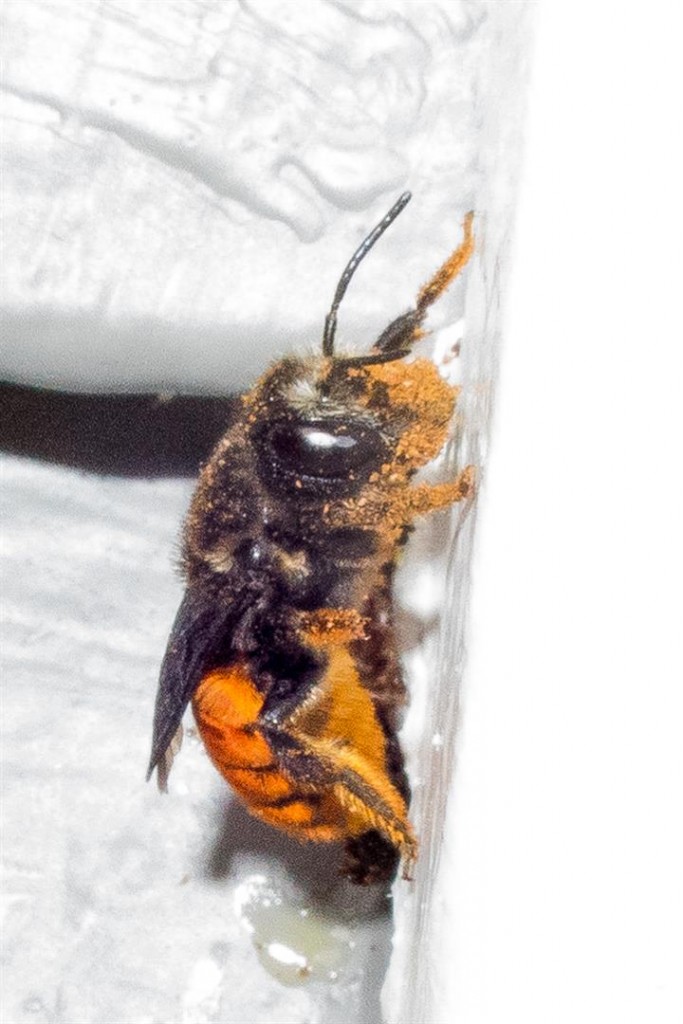
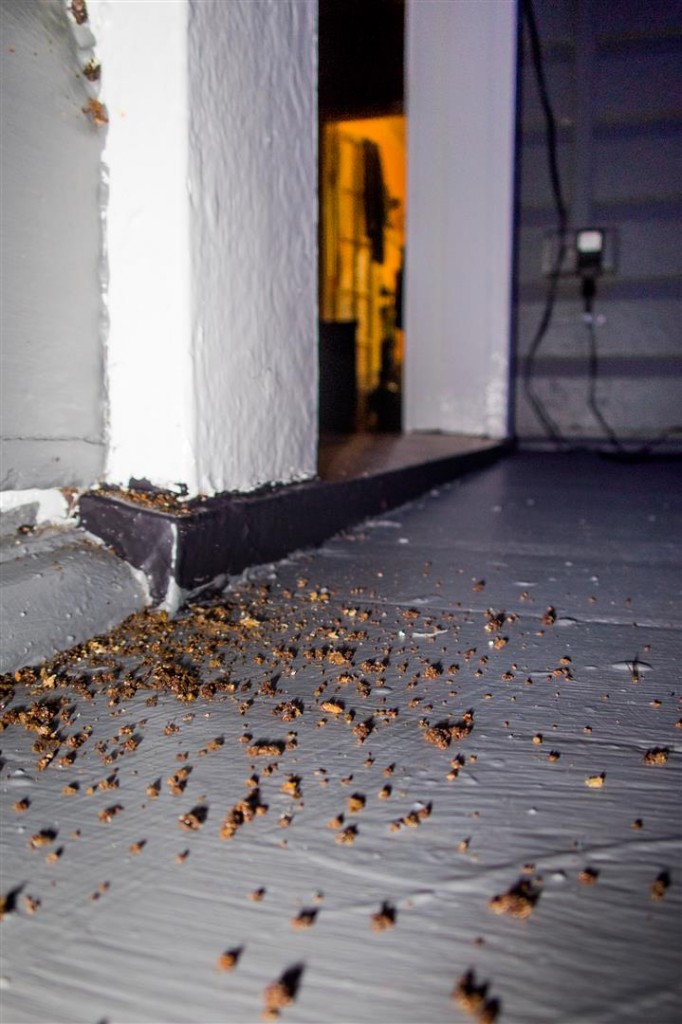
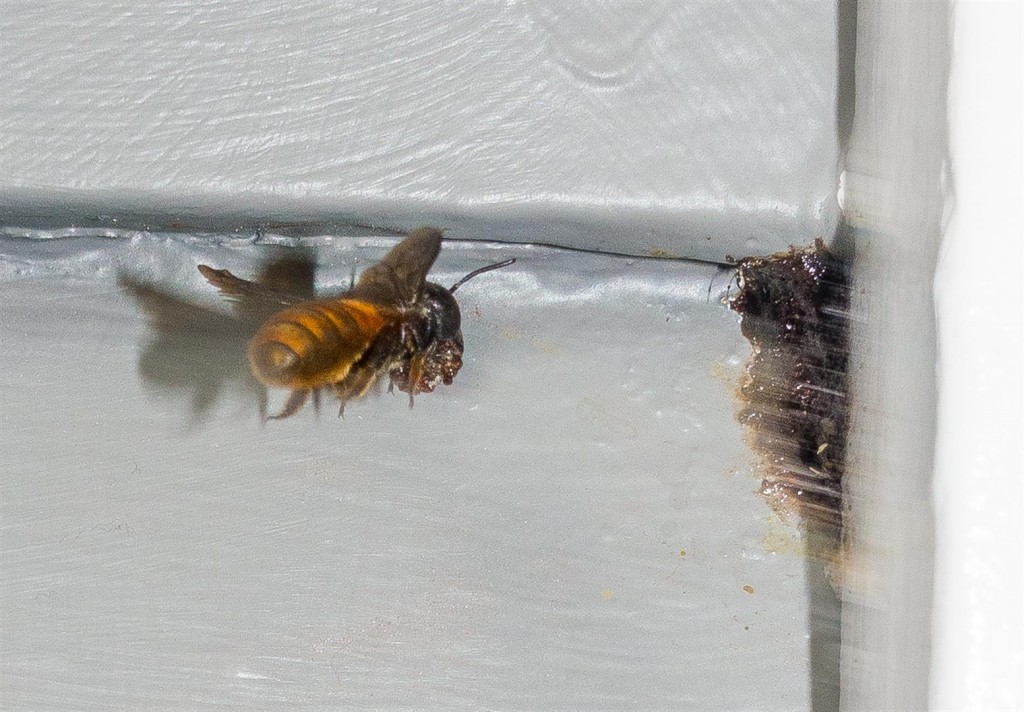
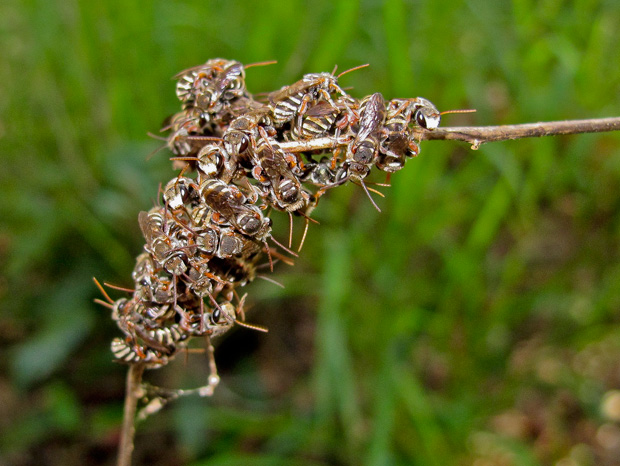
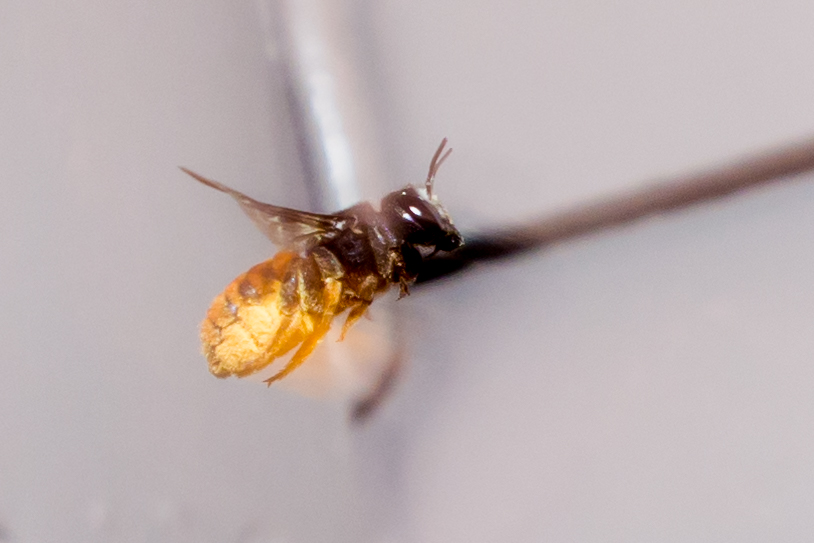
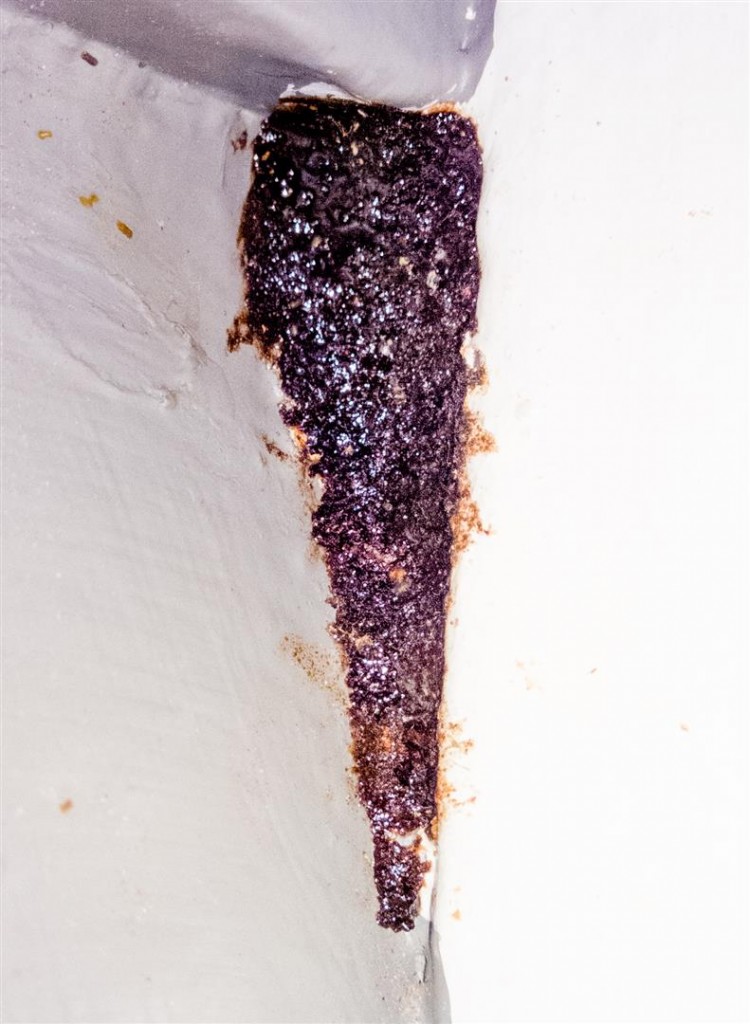
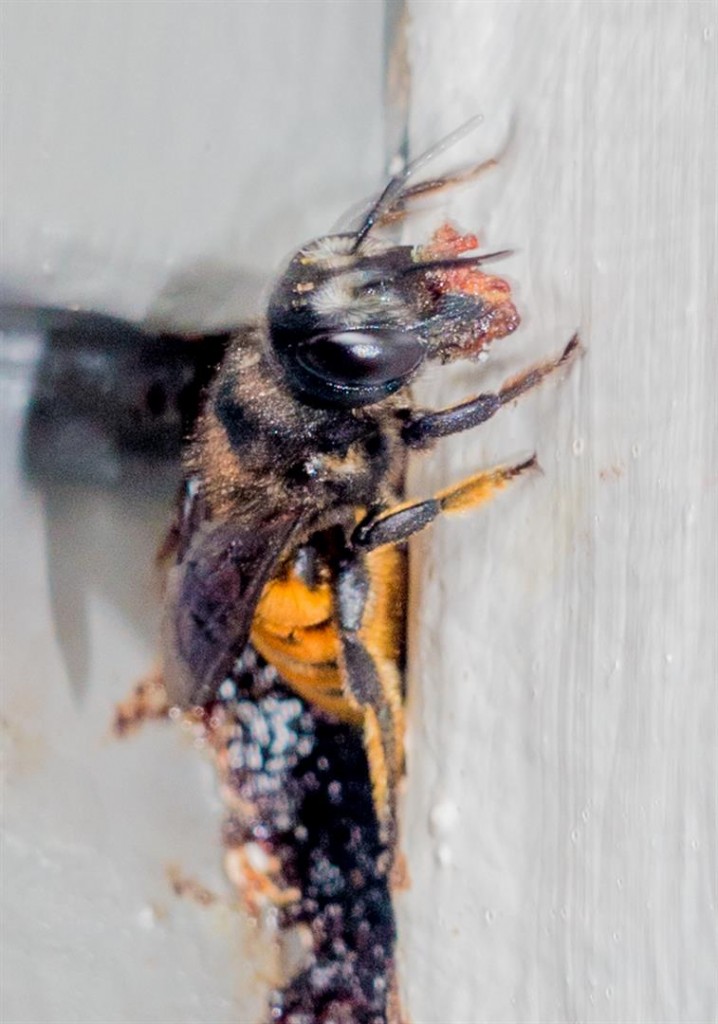
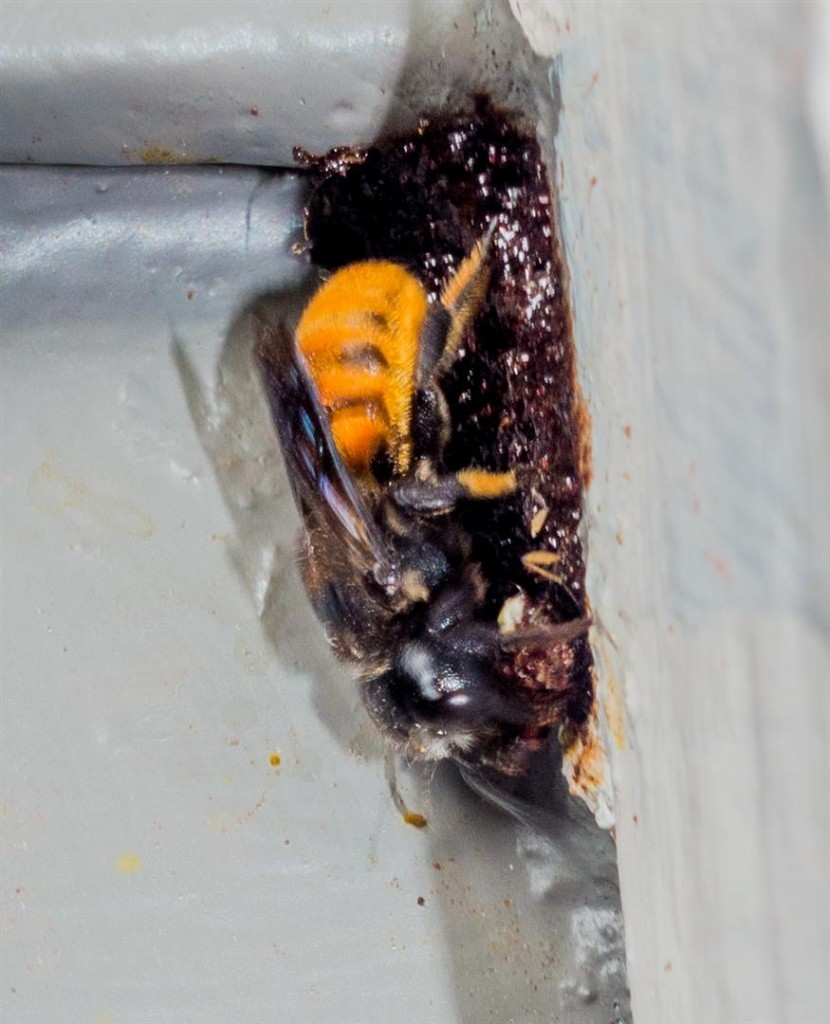
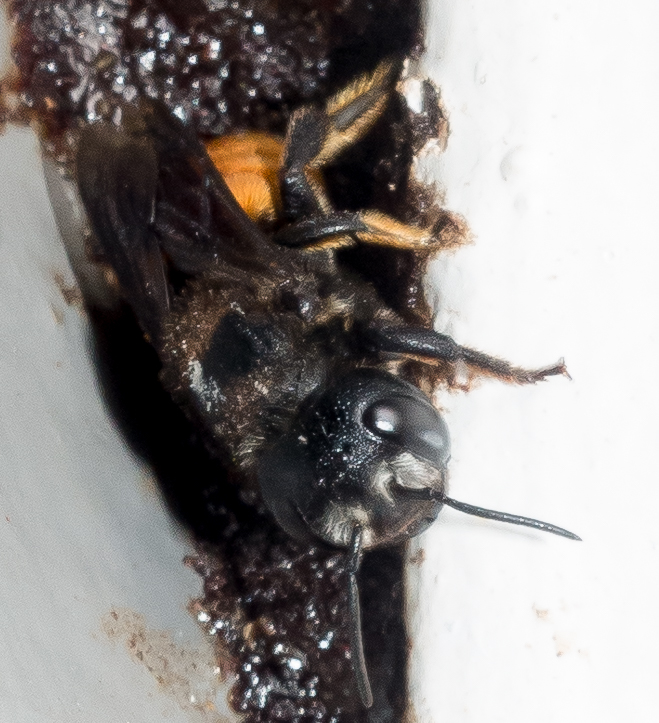
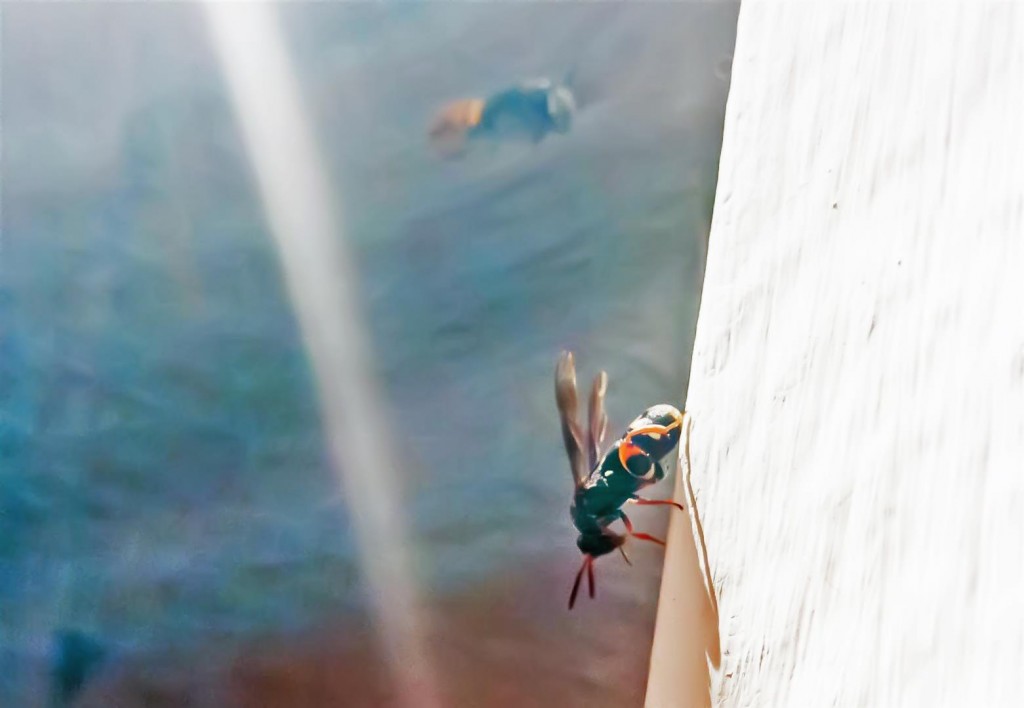
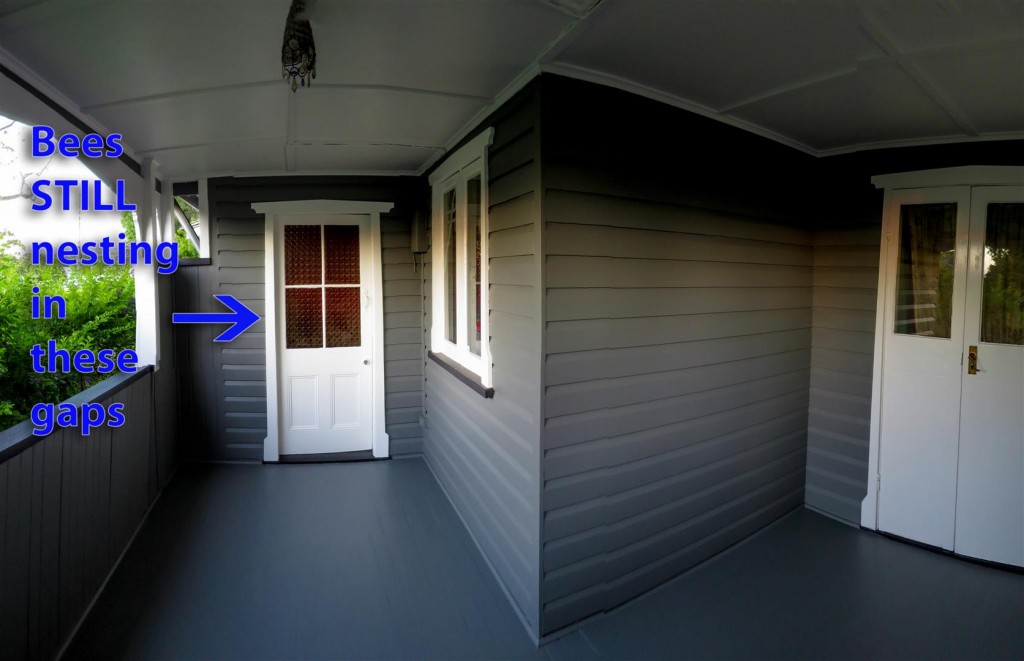
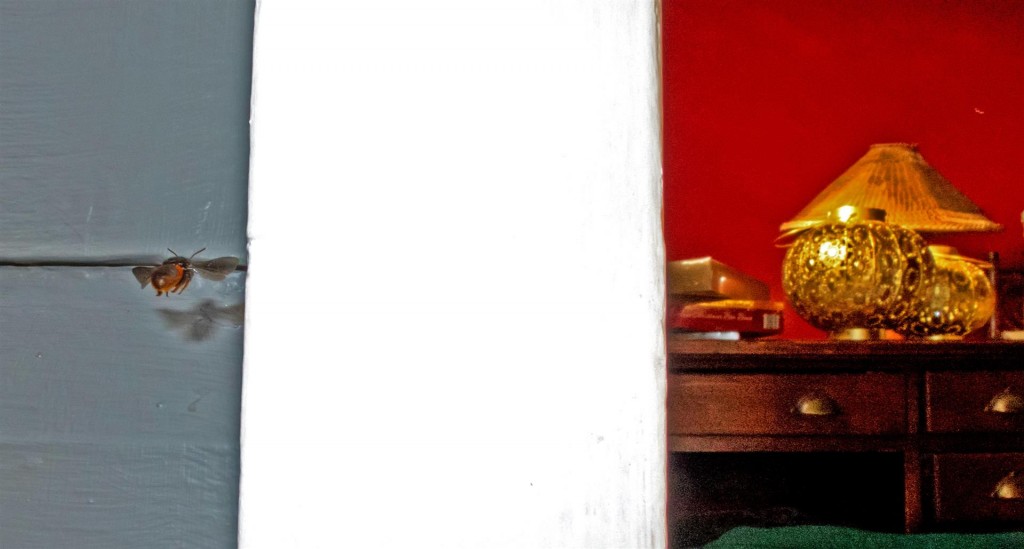
What an amazing post, Rob. I must admit I wasn’t expecting you to ever finish the painting with all those distractions and the ‘decorations’ added by the bees. They are fascinating little creatures. Thanks for the great observations, photographs, information and amusing narrative. You’ve obviously researched this topic in depth. I hope you continue to enjoy sharing your space with the bees and also get some answers to your questions.
Ha ha, thanks Jane, love those crazy insects. Cheers.
fabulously entertaining story – I must admit I would much prefer to observe the bees than paint weatherboards! Glad everything is co-existing well again x
A terrific blog post. Thanks so much for the information about the bees!
Good one Robert, interesting on two fronts, bees and reno!
Thanks for the blog comment Duncan. Love your Gippsland galleries, must return for a closer look, some beautiful images in there! Looks like a great part of the planet.
Was trying to find some information on the same yellow bummed bees I found on my verandah anc came across this. Hilarious and entertaining!
Interesting and amusing article. I found this as researching what orange bum bees are continuously entering my native stingless bee hive at the moment. Brought to my attention as Tetragonula swarming at front of hive for 2nd day today, perhaps defensively from the intruders. You did well to capture, as they land and move inside hive quickly! Love learning a new bee species
That was really interesting. We too have resin bees set up shop in our newly renovated verandah. We have left them be but gosh they make a mess. They nested in pre existing holes from and old porch roof. They have about 5 holes. I find them important but do you think I can relocate them?
Hey Shannon
They are funny little critters. Once they get a mind to nest in one spot they return each year. You could however, just before the start of summer next year, tape over the holes and hang a nest-box (for native solitary bees) there, or compensate them by putting the next box somewhere nearby where the mess they make wouldn’t be as much of a problem. Bunnings sells them, as do other garden stores these days.
https://www.etsy.com/au/listing/1359958363/bee-nest-for-solitary-bees?gpla=1&gao=1&&utm_source=google&utm_medium=cpc&utm_campaign=shopping_au_en_au_c-home_and_living-home_decor-other-other&utm_custom1=_k_CjwKCAjwiOCgBhAgEiwAjv5whAKe83cMckvRXRf_3GXrmsJ9Hah8DMwWzgm1t0zbBvk44IWym3ZYhRoCvE8QAvD_BwE_k_&utm_content=go_344323448_19782249488_78802140248_pla-328236534697_c__1359958363enau_102845289&utm_custom2=344323448&gclid=CjwKCAjwiOCgBhAgEiwAjv5whAKe83cMckvRXRf_3GXrmsJ9Hah8DMwWzgm1t0zbBvk44IWym3ZYhRoCvE8QAvD_BwE
https://www.mightyape.com.au/product/beehive-shaped-bee-house/35739035?gclid=CjwKCAjwiOCgBhAgEiwAjv5whCeDME_UBFqwUXs18UpnhazBrb9CEAxeXU2tBmLmaog5TfkoJSTISBoCfqYQAvD_BwE
https://www.mightyape.com.au/product/apoidea-bee-house/28512196?gclid=CjwKCAjwiOCgBhAgEiwAjv5whBF2ogmJCm5k0mcgzPzEgqHvzWw3JgF8YlHqqc2vugc5cYRYHQZRZhoC1n4QAvD_BwE
https://www.mightyape.com.au/product/natural-bamboo-bee-hive/35567381?gclid=CjwKCAjwiOCgBhAgEiwAjv5whIz6bbU3ZGxeZJe0ANd8DV0fxHUdTSDApnR7mPcA0iz3qNg10SMC3hoCiDMQAvD_BwE
https://www.bunnings.com.au/mr-fothergill-s-native-bee-sanctuary-kit_p0207917
Cheers
Rob